We’re moving onto drywall with a current project of ours and we’ve got 10 tips to share from our library here at the school of hard knocks. Drywall is typically the phase when the rubber meets the road (or the doo-doo hits the wind-turbine as it may be). If items like framing, hvac and plumbing weren’t adequately thought through, the drywall phase is when a lack of planning or a miscalculation becomes evident. Drywall is also one of the toughest trades to master; it takes a steady hand and a well-experienced eye. Here’s our top 10, hit that comments button and share any advice you might have.
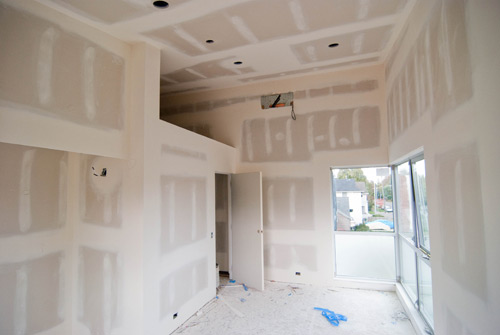
1. 5/8” GWB (Gypsum Wall Board) is always a better move than ½” GWB for thickness- it’s stiffer and hides framing imperfections. Nothing makes up for a day or two of extra work with long levels flattening walls/ ceilings and checking for other framing problems that will become evident only at the end of the project when all the interior lighting is in place.
2. Reflective lighting (i.e. off adjacent bodies of water) can create unforgiving washes of light that show every imperfection. Best to go full mud-coating and sand over complete surfaces that will get reflected light.
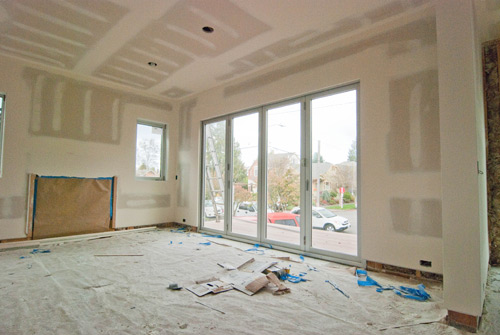
3. To reference a similar issue encountered in the recent post on framing: Think through alignment issues; door and window heads should line up inside (ideally with a sweet no-casing drywall wrap) as well as line up outside, which means the framing needs to offset so that the finish conditions align. Also, sometimes you need to offset adjacent framing so that when different types of finishes are added to surfaces, you still get alignment.
4. Triple-check wall/ceiling flatness during taping wherever cabinets meet drywall. Once cabinets are installed, an uneven wall or ceiling becomes all the more evident (even with scribes).

5. As the saying goes, God (or the devil) is in the details. We think nothing beats kerfed in door liners for a clean modern appearance. In our book, anything that can reduce the visual information presented in a wall assembly, is better. This detail requires that the interior doors be installed prior to sheetrock, and we’ve learned, they need to be secured well so they don’t shift (or get shifted) during sheetrock hanging. See our post on the modern door jamb for more info.
6. Similarly, we’ve tried numerous things for our window liners. Since we use many aluminum windows, even thermally broken units tend to expand/ contract and even ‘sweat’ a bit. So, there are a number of strategies to separate drywall from window in lieu of caulking the gap which will inevitably crack (we would say, ‘fail’) not long after install. We’ve tried drywall with an L-metal at the window edge, we graduated up to the “zip strip” (and integral drywall edge with built-in window protector that ‘zips’ out after paint), but have finally settled on poplar or mdf liners that kerf to the drywall. These create an extra line at the wall/ liner junction, but they match the doors and tend to disappear visually.
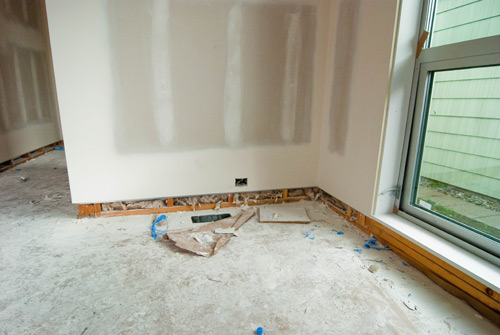
7. One other important detail is our beloved flush base. This assembly is also the result of much trial and error. We’ve landed on the following: we use a z-metal at the bottom of the sheetrock that can be installed with a laser level for accuracy. If this sounds labor intensive, a very flat sub-floor to measure from can be used, but a laser just provides a redundant check on the install. Once the Z is mudded in, we install the floor finish and then use fir or poplar as the base material. The base is site-prepped with a dato at the top inside edge, which prevents the base from binding the bottom of the Z-metal and damaging the sheetrock, as well as a miter on the bottom edge that allows the base to be scribed to the floor. The ends and corners need a bit of elastomeric to fill before paint, but otherwise, the base is ready for paint and a beautiful museum-like detail rounds out the drywall scope.
8. For areas that may need a little extra protection from damage or parts of a wall that may need to be extra flat or stable to support another material/ fixture, we use MDO (Medium Density Overlay) that can be taped directly to the adjacent sheetrock. Once painted, the MDO and sheetrock look identical, and you’ve got the ‘stronger’ wall finish in the specific location where you need it.
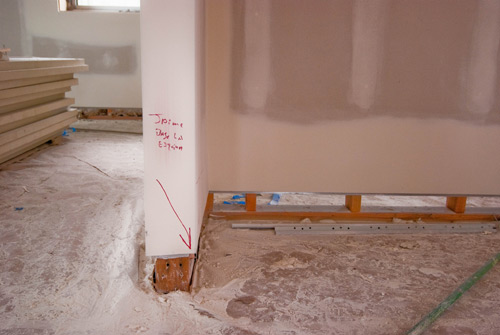
9. It’s good to know some Spanish, or at least, Spanglish, if you’re us, and not as gifted as you’d like to be with Spanish.
10. Don’t wear black to site visits.
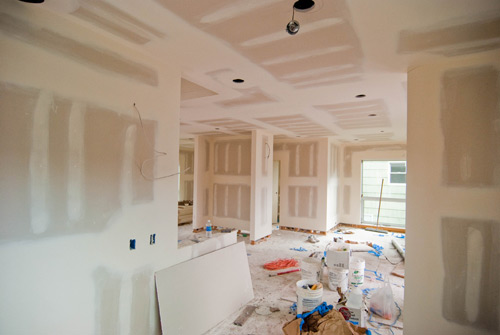
Cheers from team BUILD





